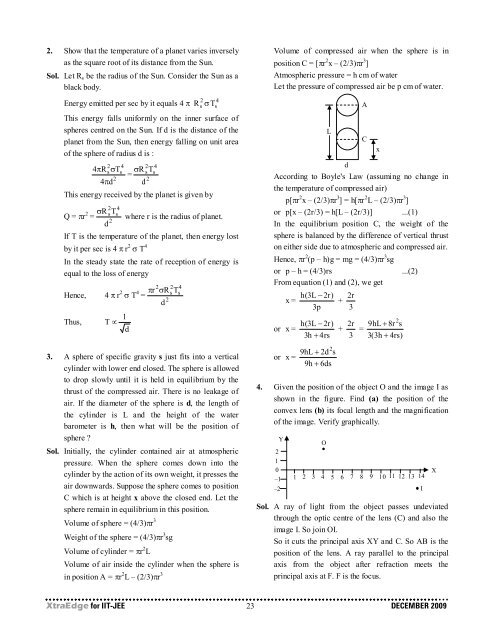You also want an ePaper? Increase the reach of your titles
YUMPU automatically turns print PDFs into web optimized ePapers that Google loves.
2. Show that the temperature of a planet varies inversely<br />
as the square root of its distance from the Sun.<br />
Sol. Let R s be the radius of the Sun. Consider the Sun as a<br />
black body.<br />
Energy emitted per sec by it equals 4 π R σ T<br />
4<br />
This energy falls uniformly on the inner surface of<br />
spheres centred on the Sun. If d is the distance of the<br />
planet from the Sun, then energy falling on unit area<br />
of the sphere of radius d is :<br />
2 4<br />
sσTs<br />
2<br />
4πR<br />
σR sTs<br />
=<br />
2<br />
4πd<br />
d<br />
This energy received by the planet is given by<br />
2<br />
4<br />
2<br />
Q = πr 2 σR sTs<br />
= where r is the radius of planet.<br />
2<br />
d<br />
If T is the temperature of the planet, then energy lost<br />
by it per sec is 4 π r 2 σ T 4<br />
In the steady state the rate of reception of energy is<br />
equal to the loss of energy<br />
Hence, 4 π r 2 σ T 4 πr σR<br />
=<br />
2<br />
d<br />
1<br />
Thus, T ∝<br />
d<br />
4<br />
2<br />
2 4<br />
s Ts<br />
3. A sphere of specific gravity s just fits into a vertical<br />
cylinder with lower end closed. The sphere is allowed<br />
to drop slowly until it is held in equilibrium by the<br />
thrust of the compressed air. There is no leakage of<br />
air. If the diameter of the sphere is d, the length of<br />
the cylinder is L and the height of the water<br />
barometer is h, then what will be the position of<br />
sphere ?<br />
Sol. Initially, the cylinder contained air at atmospheric<br />
pressure. When the sphere comes down into the<br />
cylinder by the action of its own weight, it presses the<br />
air downwards. Suppose the sphere comes to position<br />
C which is at height x above the closed end. Let the<br />
sphere remain in equilibrium in this position.<br />
Volume of sphere = (4/3)πr 3<br />
Weight of the sphere = (4/3)πr 3 sg<br />
Volume of cylinder = πr 2 L<br />
Volume of air inside the cylinder when the sphere is<br />
in position A = πr 2 L – (2/3)πr 3<br />
2<br />
s<br />
s<br />
Volume of compressed air when the sphere is in<br />
position C = [πr 2 x – (2/3)πr 3 ]<br />
Atmospheric pressure = h cm of water<br />
Let the pressure of compressed air be p cm of water.<br />
L<br />
d<br />
According to Boyle's Law (assuming no change in<br />
the temperature of compressed air)<br />
p[πr 2 x – (2/3)πr 3 ] = h[πr 2 L – (2/3)πr 3 ]<br />
or p[x – (2r/3) = h[L – (2r/3)] ...(1)<br />
In the equilibrium position C, the weight of the<br />
sphere is balanced by the difference of vertical thrust<br />
on either side due to atmospheric and compressed air.<br />
Hence, πr 2 (p – h)g = mg = (4/3)πr 3 sg<br />
or p – h = (4/3)rs ...(2)<br />
From equation (1) and (2), we get<br />
h(3L<br />
− 2r)<br />
x =<br />
+<br />
3p<br />
h(3L − 2r)<br />
or x =<br />
+<br />
3h + 4rs<br />
or x =<br />
2<br />
9hL + 2d s<br />
9h + 6ds<br />
2r<br />
3<br />
A<br />
C<br />
x<br />
2 r 9hL + 8r s<br />
=<br />
3 3(3h + 4rs)<br />
4. Given the position of the object O and the image I as<br />
shown in the figure. Find (a) the position of the<br />
convex lens (b) its focal length and the magnification<br />
of the image. Verify graphically.<br />
2<br />
1<br />
0<br />
–1<br />
–2<br />
Y<br />
O<br />
1 2 3 4 5 6 7 8 9 10 11 12 13 14<br />
Sol. A ray of light from the object passes undeviated<br />
through the optic centre of the lens (C) and also the<br />
image I. So join OI.<br />
So it cuts the principal axis XY and C. So AB is the<br />
position of the lens. A ray parallel to the principal<br />
axis from the object after refraction meets the<br />
principal axis at F. F is the focus.<br />
2<br />
I<br />
X<br />
XtraEdge for <strong>IIT</strong>-<strong>JEE</strong> 23 DECEMBER 2009

















